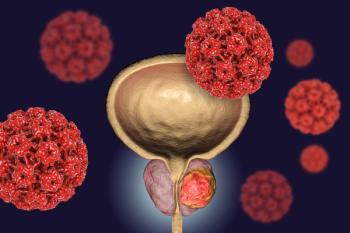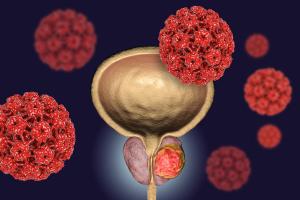
Experts in the field review integration of approved PARP inhibitors into advanced prostate cancer clinical practice.

Your AI-Trained Oncology Knowledge Connection!


Experts in the field review integration of approved PARP inhibitors into advanced prostate cancer clinical practice.

This video examines a phase III study that tested the addition of docetaxel and prednisone to standard therapy as adjuvant treatment for men with high-risk localized prostate cancer.

In 2008, approximately 186,000 American men were diagnosed with prostate cancer, resulting in about 28,600 deaths.[1] It is the most commonly diagnosed cancer, and second only to lung cancer as the leading cause of cancer death in men.

While organ preservation with nonextirpative surgery, radiotherapy,and frequently, chemotherapy has become a favored strategy in thetreatment of many cancers, bladder preservation for patients with invasivedisease remains controversial. The standard treatment for muscleinvasivebladder cancer in the United States is still radical cystectomywith pelvic lymph node dissection. An alternative to cystectomy ismultimodality bladder preservation with thorough transurethral resection,chemotherapy, and radiation therapy. This review will addressissues raised by a multimodality approach for the treatment of invasivebladder cancer.

As Dr. Raghavan has emphasizedin his excellent overviewof the current therapyfor testis cancer, it is critical that thesuccess of therapy for this diseasenot be compromised by a desire toavoid the complications of therapy.We would wholeheartedly agree withhis assertion that modifications intherapy must be introduced with athoughtful and structured approachto minimize the risk to efficacy.

The goal of identifying a set of pretreatment risk-stratifying factors for patients with localized prostate cancer is to be able to individualize treatment and optimize patient selection for clinical trials. Low-risk patients are most likely

Current controversies in the treatment of stage I seminoma center on the relative roles of surveillance, adjuvant radiotherapy (RT), and adjuvant single-agent chemotherapy. Surveillance has been studied in over 800 patients,

Published: March 17th 2021 | Updated:

Published: August 1st 2001 | Updated:

Published: September 11th 2009 | Updated:

Published: February 1st 2003 | Updated:

Published: August 1st 1998 | Updated:

Published: June 2nd 2015 | Updated: